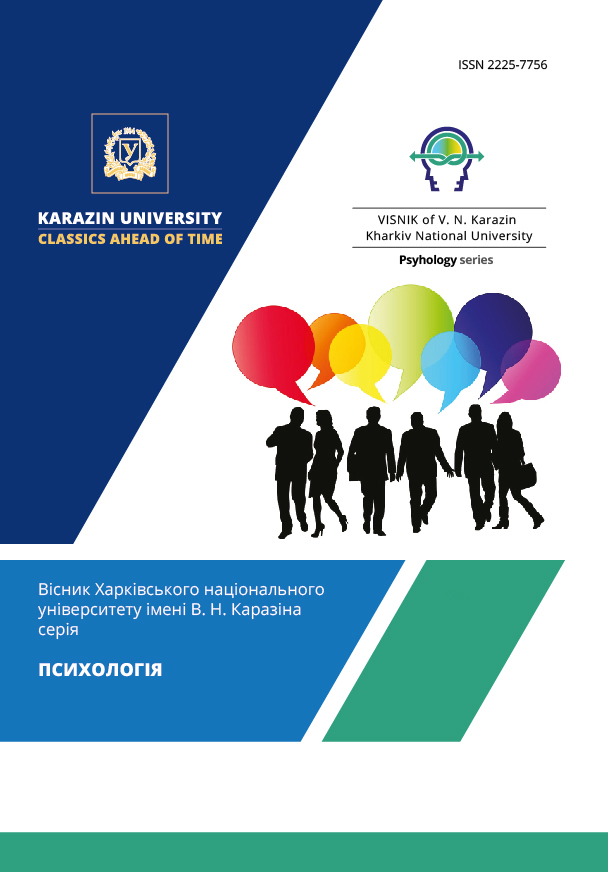To the Question of Attitude to Death of Middle-Aged People During the War in Ukraine
Abstract
A person's attitude to death is influenced by the critical situations he encounters in his life. The war, which began in Ukraine at the beginning of 2022, made people's feelings about death relevant, because death has become everyday reality in the lives of Ukrainians. The purpose of the study is to determine the peculiarities of middle-aged people attitude to the phenomenon of death during the war in Ukraine. A sample of subjects (N=76) who previously participated in our research in 2019 and 2020 during the coronavirus infection. The age of the subjects varies as follows: Me=44.00; min=35.00; max=55.00. Research methods: the "Attitude to Death" method (I.Yu. Kulagina, L.V. Senkevich), the "Attitude to Death Scale" method by D.V. Hardt, Metaphor of Personal Death technique – the Revised Death Fantasy Scale (RDFS) J. McLennan. It was determined that the attitude towards death in people of the studied middle-aged group during the war is ambivalent with a certain deviation towards the positive. The studied group is characterized by an average level of stress resistance, which is associated with thoughts about death. The choice of metaphors about death is determined by the degree of attitude positivity towards death: a pessimistic attitude towards death is associated with negative thoughts about death, fixation on its external side, avoidance of contact with death. Lack of seeing a positive perspective in death leads to pessimism and negative thoughts. An optimistic attitude towards death is associated with the rare occurrence of negative thoughts about own death, perception of death as a necessary aspect of being, openness to contact with death. Significant differences were found between believers and atheists on the indicator of positive thoughts about their own death: believers showed a high level of acceptance of death. Significant differences in attitudes toward death between men and women were also identified: men have a more positive and "black" humor to thoughts about death.
Downloads
References
Cardozo, B., Vergara, A., Agani, F. et al. (2000). Mental Health, Social Functioning, and Attitudes of Kosovar Albanians Following the War in Kosovo. JAMA, 284(5), 569-577. https://doi.org/10.1001/jama.284.5.569
Cardozo, B.L., Bilukha, O.O., Crawford, C.A., Shaikh, I., Wolfe, M.I., Gerber, M.L., Anderson, M. (2004). Mental health, social functioning, and disability in postwar Afghanistan. JAMA, 4(292), 575-584. https://doi.org/10.1001/jama.292.5.575.
De Jong, K., Van der Kam, S., Ford, N. (2004). Trauma of Chechnya's ongoing war on internally displaced people. Lancet, 1. http://www.uk2.msf.org/reports/chechnya.htm
De Jong, K., Van der Kam, S., Ford, N., Hargreaves, S. et. al. (2007). The trauma of ongoing conflict and displacement in Chechnya: quantitative assessment of living conditions, and psychosocial and general health status among war displaced in Chechnya and Ingushetia. NL of M, 1. https://doi.org/10.1186/1752-1505-1-4.
Dvornyk, M.S., Myronchak, K.V. (2021). Innovative means of psychological assistance to the individual in the conditions of hybrid war. Kyiv. https://lib.iitta.gov.ua/728210/1/
Feifel, H. (1993). The Problem of Death. Illness, Crisis & Loss, 3(1), 29–34. https://doi.org/10.2190/IL3.1.e.
Fischer, I.C., Secinti, E. (2022). Examination of the relationships between religiosity and death attitudes in Turkey and the United States. Death Studies, 46(1), 157-167. https://doi.org/10.1080/07481187.2020.1723742.
Forther, B.V., Neimeyer, R.A. (1999). Death Anxiety in Older Adults: a Quantitative Review. Death Studies, 23(5), 387-411.
Freud, Z. (1993). Reflections upon War and Death. (Ph. Rieff, Ed.). New York: Collier Books.
Granville-Chapman, C. (2004). Rape and other torture in the Chechnya conflict: documented evidence from asylum seekers arriving in the United Kingdom, 4. http://www.torturecare.org.uk/publications/reportChech.htm
Hardt, D.V. (1975). Development of an investigatory instrument to measure attitudes toward death. Journal of School Health, 45, 96–99. https://doi.org/10.1111/j.1746-1561.1975.tb07672.x.
Kulagina, I.Yu. (2013). Attitude to death: age, regional and gender differences. Kulturno-ystorycheskaia psykholohyia, 9(4), 58–64.
Levinson, D. J., & Gooden, W. E. (1985). The life cycle. (H. I. Kaplan & B. J. Sadock, Eds.), Baltimore, MD: Williams and Williams.
Mironchak, K.V. (2012). Psychological impact of the fear of death on personality. Naukovyi visnyk Lvivskoho derzhavnoho universytetu vnutrishnikh sprav. seriia psykholohichna, 2(2), 361-370.
Mollica, R.F., McInnes, K., Sarajlić, N., Lavelle, J., Sarajlić, I., Massagli, M.P. (1999). Disability associated with psychiatric comorbidity and health status in Bosnian refugees living in Croatia. JAMA, 282(5). https://doi.org/10.1001/jama.282.5.433
Mollica, R.F., Sarajlic, N., Chernoff, M., Lavelle, J., Vukovic, I.S., Massagli, M.P. (2001). Longitudinal study of psychiatric symptoms, disability, mortality, and emigration among Bosnian refugees. JAMA, 286(5). https://doi.org/10.1001/jama.286.5.546
Morris Trainor, Z., Jong, J., Bluemke, M., & Halberstadt, J. (2019). Death Salience Moderates the Effect of Trauma on Religiosity. Psychological Trauma: Theory, Research, Practice, and Policy, 11(6), 639-646. https://doi.org/10.1037/tra0000430
Neimeyer, R.A., Wittkowski, J., Moser, R.P. (2004). Psychological research on death attitudes: an overview and evaluation. Death Studies, 28(4), 309-40. https://doi.org/10.1080/07481180490432324.
Psychological diagnostics: the "Death Attitude Scale" technique (Dale Hardt V.). https://sites.google.com/site/test300m/skos
Rose, M. Fighting for peace: Bosnia, 1994. (1999). New York: Time Warner Paperbacks.
Salama, P., Spiegel, P., Van Dyke, M., Phelps, L, Wilkinson, C. (2000). Mental health and nutritional status among the adult Serbian minority in Kosovo. JAMA, 284(5). 578-584. https://doi.org/10.1001/jama.284.5.578
Sinoff, G. (2017). Thanatophobia (Death Anxiety) in the Elderly: the Problem of the Child’s Inability to Assess Their Own Parent’s Death Anxiety State. Frontiers in Medicine, 4. https://doi.org/10.3389/fmed.2017.00011
Smith, P., Perrin, S., Yule, W., Hacam, B., Stuvland, R. (2002). War exposure among children from Bosnia-Herzegovina: psychological adjustment in a community sample. Trauma Stress, 15(2). 147-156.
Westermeyer, J. (2000). Health of Albanians and Serbians following the war in Kosovo: studying the survivors of both sides of armed conflict, JAMA, 284(5), 615-626. https://doi.org/10.1001/jama.284.5.615
Yalom, I. Staring at the sun. Overcoming fear. (2020). Kharkiv: KSD.
Yanovska, S., Turenko, R., Timchenko, V. (2020). Attitudes to Death of Middle-Aged in the Context of the Covid-19 Pandemic. Visnyk of V.N. Karazin Kharkiv National University. Series “Psychology”, 69, 55 - 63. https://doi.org/10.26565/2225-7756-2020-69-08




